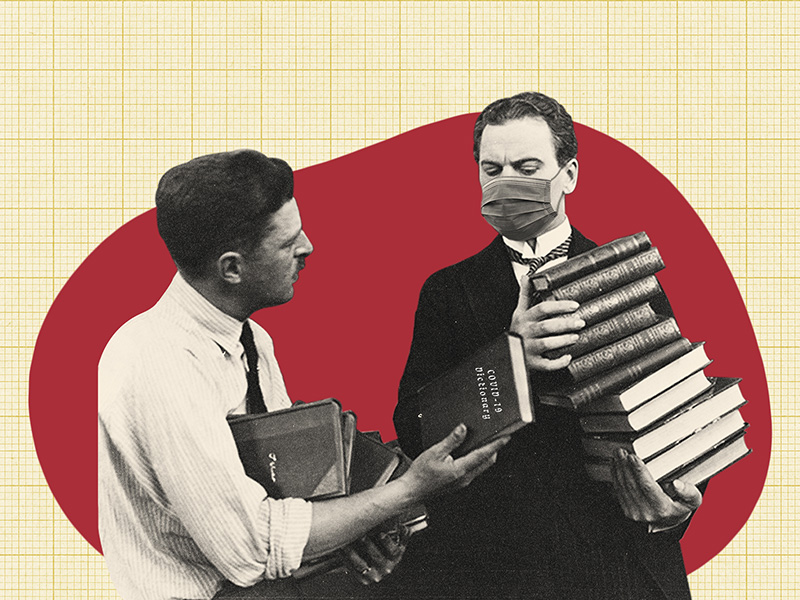
“Language, never forget, is more fashion than science, and matters of usage, spelling and pronunciation tend to wander around like hemlines.” ― Bill Bryson, ‘The Mother Tongue: English and How It Got That Way’.
Let’s spare a thought for lexicographers. Compiling a dictionary must be a mind-bending feat at the best of times: English speakers have millions of words at their disposal, yet we conjure up another thousand or so ‘neologisms’ annually just for the hell of it.
Before the computer age, common tech words like blog, vlog, selfie, shoefie, google (the verb), sexting, and e-‘insert appropriate noun’ were unknown to even the most erudite wordsmiths. The coronavirus pandemic has supplied the English-speaking world with yet more artillery for new words, and the people have duly obliged with Twitter-trending portmanteaus and conversational compounds.
Meanwhile technical jargon has become part of the daily lexicon (for better or worse), and the world of epidemiology has birthed into existence words – such as Covid-19 and Sars-Cov-2 – which have reshaped the face of human history.
There’s awkward and then there’s “the zoom meeting is over and you and one other person can’t figure out how to leave the meeting” awkward.
— Snarky Mommy (@SnarkyMommy78) April 2, 2020
Neologisms
Zoom – Virtual meeting app, Zoom, climbed from 10 million daily users in 2019 to 200 million daily users by March 2020. This meteoric rise echoed Google at the turn of the 21st century, once battling for search engine superiority against the likes of Yahoo, MSN and Ask Jeeves, but now holding around three-quarters of the global market share. Google became a verified English verb in 2006; if Zoom increasingly becomes shorthand for ‘video call’, will we see it heading the same way?
Covidiots – Generally attributed to the Urban Dictionary, a ‘covidiot’ is a person with poor coronavirus etiquette, such as hoarding goods or ignoring public health warnings. The Urban Dictionary’s example states: “Did you see that covidiot with 300 rolls of toilet paper in his basket?”. Of course, this has led to further conjugations, such as ‘covidiocy’ and ‘novidiots’.
Coronavision – A little double entendre, ‘coronavision’ trended on social media as a virtual song contest in lieu of the cancelled Eurovision 2020, before British optometrists used it to describe the recent epidemic of eye problems and deteriorating vision among homebound Britons. Based on an independent study, as many as one-in-five claimed their vision worsened during the pandemic, a third of whom attributed it to increased screen time.
Anti-masker – The fact the English language needs the term ‘anti-masker’ – used to group together and admonish those refusing to wear facemasks during the pandemic – is a sign of how divided societies have become. Though the US probably tops the league of mask polarization (with a history of mask disputes dating back to the Spanish flu epidemic of 1918), the term also surfaced in Japan in the wake of Tokyo’s recent anti-mask protests.
Abenomask – Few in Japan will forget the epic failure of the Prime Minister’s ‘Abenomask’: a campaign to deliver a grand total of two masks to every Japanese household (a significant portion of which arrived at their destinations covered in mold). Made from what felt like folded sandpaper and barely large enough to straddle the average pair of lips, the mask venture cost over ¥46 billion in taxpayer money.
https://www.instagram.com/p/B9ntz0XAjVD/?utm_source=ig_embed
Linguistic Appropriation
Social Distancing – The phrase of 2020 so far, ‘social distancing’, has been around since at least the 1950s, when sociologist Karl Mannheim used it describe how the upper classes distinguished themselves from their subordinates and inferiors – which actually sounds much more on point, come to think of it. The WHO also preached social distancing during the 2009 flu pandemic, though the seemingly arbitrary two-meter stipulation was only added by the US CDC this year. The WHO actually prefers ‘physical distancing’ instead, given infectious diseases have yet to find a way to spread virtually, but are more than adept in physically crowded areas.
Space Marshal – Social distancing has given rise to another new term – and perhaps a new occupation – the ‘space marshal’. Rather than being a member of an intergalactic police force, however, these folks are in charge of ensuring appropriate distance is maintained at public events.
Immunocompromised Shoppers – The phrase may sound Tom Clancy-esque, but immunocompromised shoppers have less to do with failed tactical espionage and more to do with being over the proverbial hill. Immunocompromised has been in use for at least 40 years, ascribed to people at high-risk from the effects of disease due to weakened immune systems. Though as the coronavirus pandemic led to early shopping hours exclusively for the elderly and disabled, ‘immunocompromised shoppers’ came into vogue.
Lockdown – In its current form, ‘lockdown’ came into usage in the 1970s, referring to prisoners’ extended periods of confinement. It was later appropriated to mean enforced isolation, but at no time in history has it been so freely employed as in 2020. In fact, one would argue, it has morphed into its own contracted time period, forever carrying with it connotations of loneliness and depression.
Lockdown Day: ???? pic.twitter.com/KttXOTbPCA
— flatback4 (@flatb4ck) April 21, 2020
Technical Terms
Superspreader – Not a knife that’s particularly skilled at buttering toast, I’m afraid, a ‘superspreader’ is a very contagious organism infected with a disease. In the current pandemic, it refers to Covid-19 carriers who spread the disease to a large amount of previously uninfected people.
Virus Clusters – ‘Virus clusters’ are another linguistic red herring, representing the people carrying the pathogens, as opposed to the pathogens themselves. The term refers to groups of people infected by the disease bound by time and geographic location; in other words, a cluster of people infected in the same place, often simultaneously. Identifying these clusters has been at the forefront of the coronavirus response efforts.
Contact Tracing – Few in the general public were familiar with ‘contact tracing’ before it began appearing in newspaper articles early this year. The method by which virus clusters and the movements of an infectious disease are identified, contact tracing has been vital in the prevention of epidemics for hundreds of years – some evidence suggests it was used to track down the source of the bubonic plague in 16th-century Italy.
Flattening the Curve – The land of the flattened curve has become 2020’s El Dorado. As the novel coronavirus metastasized outward from China at a frightening rate, predictive graphs and models of infection rates showed curves slowly rising before climbing exponentially like a paper plane flying into an updraft. Once we begin flattening those curves, we are one step closer to a world no longer in fear of Covid-19.








